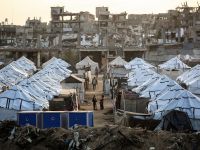The small farming community of Jurf Al-Sakhar lies in Iraq’s south, to the East of Fallujah in the Euphrates River Valley. A decade of disenfranchisement targeting the Sunni community meant that when ISIS arrived here in 2014, many of the locals sought their protection.
The problem was that Jurf Al-Sakhar lies in strategic territory on a pilgrimage route used by Shia religious pilgrims to travel to Karbala, a city with a historic Iranian influence.
In 2014 the town residents were massacred and thousands were displaced by Shia militia loyal to Iran. In what was billed as a great victory against ISIS, the area became a ghost town. It’s orange trees and palm groves were set on fire. Members of the Sunni community either fled, or were assassinated.
Recently released intelligence cables show that elements inside Tehran were beginning to worry about the long-term consequences of systematic Sunni oppression, particularly in Iraq's south. One cable read “groups and individuals who had been fighting against the Americans among the Sunnis are now wishing that not only America, but even Israel, would enter Iraq and save Iraq from Iran’s clutches.”
Increasingly the cables blamed one man: General Qassem Suleimani, leader of Iran’s Revolutionary Guards, architect of Tehran’s infiltration into Iraq, Syria and Yemen, and ‘martyr’ as of January 3rd 2020, when hellfire missiles fired from a US Reaper Drone marked a new escalation in the Iranian cold war.
Increasingly the cables blamed one man: General Qassem Suleimani, leader of Iran’s Revolutionary Guards, architect of Tehran’s infiltration into Iraq, Syria and Yemen, and ‘martyr’ as of January 3rd 2020, when hellfire missiles fired from a US Reaper Drone marked a new escalation in the Iranian cold war.
Over the past week mainstream news networks that had never once mentioned Suleimani have offered blanket coverage and opinion on the “talismanic” leader. As both Iran and Iraq staged massive funerals for the general, many have depicted his assassination as galvanizing rather that weakening Iran.
Progressive spokespersons from the leftist wing of the Democratic Party have written eulogies. On the conservative right a chorus of pundits have downplayed the costs of further escalation.
What few have pointed out is that many inside Tehran will be privately delighted that Suleimani is dead: including the supreme leader, Ayotallah Ali Khamenei.
What few have pointed out is that many inside Tehran will be privately delighted that Suleimani is dead: including the supreme leader, Ayotallah Ali Khamenei.
The IRGC was formed in April 1979 as a neo-praetorian guard for the personal protection of Ayatollah Khomeini and the continuation of an Islamic Revolution that the rest of the world neither predicted nor believed would last.
Over the course of the following three decades the group amassed fantastic economic power inside Iran and globally. The surveillance of Iranian society is controlled by the Guards Corp. Iran’s ambassadors are selected from their ranks. Short of the Ayatollah himself, no other entity inside Iran wields so much power. That made Suleimani one of the three most powerful men in Iran next to the Supreme Leader and the President, Hassan Rouhani. Some believed that Suleimani would outlive them both – practically, and politically.
As early as 2014 agents from Iran’s rival intelligence agency, the Ministry of Intelligence (MOIS), suspected that the anti-ISIS campaign in Iraq’s south might serve as the platform for Suleimani to begin a political career back home. One report, which specifically states it should not be shared with the IRGC, points to how the General was “publishing pictures of himself on different social media sites.”
As early as 2014 agents from Iran’s rival intelligence agency, the Ministry of Intelligence, suspected that the anti-ISIS campaign in Iraq’s south might serve as the platform for Suleimani to begin a political career back home.
While the IRGC was born out of the Islamic Revolution, Iran’s Ministry of Intelligence has been traditionally more affiliated with the country’s Republican past. Cautiously regarded by the U.S. State Department as more technocratic, less ideological and closer to the office of the President, there is evidence that the two agencies engage in spying on each other.
Recent cables have shown that during a secret 2014 meeting between the IRGC and the Muslim Brotherhood in Turkey, a Ministry of Intelligence operative was in the room to observe his Iranian counterpart. There’s no doubt that the Ministry remains threatened by the outsized influence of the Guards. The demise of Suleimani will have occasioned a hushed sigh of relief among all those in Tehran that still cling to the last vestiges of a suppressed republican past.

A ritual of mourning for General Qassem Suleimani, Azadi Freedom Tower in Tehran, 3rd January /AFP
For Ayotallah Khamenei, the death of Suleimani will create new opportunities. The appointment of Esmail Ghaani as a less politically potent and less charismatic replacement will bolster the Supreme Leader’s own authority during a time of internal dissent. Iran’s foreign adventures abroad have depleted its economy and led to severe riots and domestic insurrection across the country.
The demise of Suleimani will have occasioned a hushed sigh of relief among all those in Tehran that still cling to the last vestiges of a suppressed republican past.
Some reports suggest that Khamenei had sought to consolidate power at home, with the IRGC intent on retaining and expanding its lucrative mercenaries across the key battlegrounds of the region. Iran’s imperial overreach is costing it heavily – the assassination of Suleimani might occasion a rethink.
There’s also the question of reform within the IRGC itself. In July 2018 the New York Times reported how Mossad agents infiltrated a warehouse and removed 50,000 pages and 163 compact discs of memos, videos and nuclear plans inside Iran. Before this, the death of General Hassan Tehrani Moghaddam in a 2011 explosion near Tehran, and the assassination of Iranian nuclear scientists between 2010 and 2012 were not deemed accidents. In August last year Mahmoud Alavi, Iran’s minister of intelligence, suggested that external enemies had infiltrated the IRGC.
In August last year Mahmoud Alavi, Iran’s minister of intelligence, suggested that external enemies had infiltrated the IRGC.
Suleimani’s death has provided the Iranian regime a propagandistic opportunity for national rituals of mourning and defiance. It’s accentuated the role of the Supreme Leader, and helped unify Iranians around a common external enemy. It’s removed a potential challenge to Khamenei’s rule, but also created a vacuum in the country’s intelligence agencies that could provide an opening for republican elements in the future.
It remains to be seen whether the assassination of Suleimani will act as a catalyst for a wider changing of the guard inside Iran. Behind the scenes, not everybody is in mourning.
The views expressed in this article do not necessarily reflect those of Al Bawaba News.







